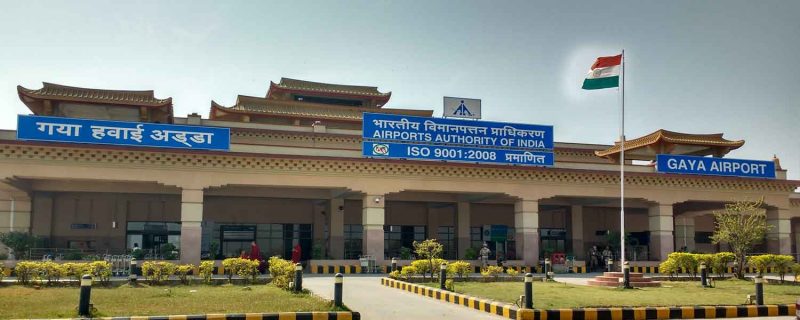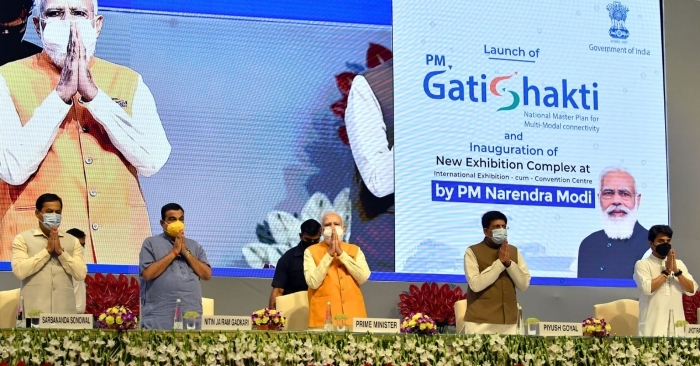India pushes for economic growth with launch of ‘PM Gati Shakti–National Master Plan for Multimodal Connectivity’
The approach is driven by engines of growth in the following seven sectors: Railways; Roads; Ports; Waterways; Airports; Mass Transport and; Logistics Infrastructure aimed at creating a $5 trillion economy.
By R. Chandrakanth
On India’s 75th Independence Day in 2021, Prime Minister Narendra Modi announced the government would launch ‘PM Gati Shakti Master Plan for Multimodal Connectivity’, a project for developing ‘holistic infrastructure’.
‘Gati Shakti’ roughly translated from Hindi means ‘Power of Speed’ and the government had speed of economic growth in mind.
The Prime Minister launched on October 13, 2021 in New Delhi, heralding a new chapter in governance, the Gati Shakti—a digital platform—that is expected to bring 16 Ministries including Railways and Roadways together for integrated planning and coordinated implementation of infrastructure connectivity projects.
It incorporates the infrastructure schemes of various Ministries and State Governments like Bharatmala, Sagarmala, inland waterways, dry/land ports, UDAN (regional air connectivity scheme) etc.
Economic Zones like textile clusters, pharmaceutical clusters, defence corridors, electronic parks, industrial corridors, fishing clusters, agri zones are covered to improve connectivity and make Indian businesses more competitive.
It intends to leverage technology extensively including spatial planning tools from the Indian Space Research Organisation (ISRO) imagery developed by BiSAG-N (Bhaskaracharya National Institute for Space Applications and Geoinformatics). The intent is to facilitate last-mile connectivity of infrastructure and also reduce travel time for people.
Seven engines of growth
“PM Gati Shakti” is a transformative approach for economic growth and sustainable development. The approach is driven by seven engines – a) Railways; b) Roads; c) Ports d) Waterways; e) Airports; f) Mass Transport and g) Logistics Infrastructure.
All seven engines are expected to pull forward the economy in unison. These engines are supported by the complementary roles of Energy Transmission, IT Communication, Bulk Water & Sewerage, and Social Infrastructure. The approach is powered by Clean Energy and Sabka Prayas – the Central Government, the state governments, and the private sector together – leading to huge job and entrepreneurial opportunities.
The scope of the Master Plan will encompass the 7 engines for economic transformation, seamless multimodal connectivity and logistics efficiency. It will also include the infrastructure developed by the State Governments, with focus on planning, financing including through innovative ways, use of technology and speedier implementation.
World-class modern infrastructure
The projects pertaining to these 7 engines in the “National Infrastructure Pipeline” will be aligned with PM Gati Shakti framework. The touchstone of the Master Plan will be world-class modern infrastructure and logistics synergy among different modes of movement – both of people and goods – and location of projects. This will help raise productivity and accelerate economic growth and development.
The plan has been developed as a Digital Master Planning tool by BISAG-N and has been prepared in dynamic Geographic Information System (GIS) platform wherein data on specific action plan of all the Ministries/Departments have been incorporated within a comprehensive database. Dynamic mapping of all infrastructure projects with real-time updates will be provided by way of a map developed by BISAG-N.
The map will be built on open-source technologies and hosted securely on MEGHRAJ i.e., cloud of Government of India. It will use satellite imagery available from ISRO and base maps from Survey of India. The comprehensive database of the ongoing & future projects of various Ministries has been integrated with 200 plus GIS layers thereby facilitating planning, designing and execution of the infrastructure projects with a common vision.
Data of ministries on one platform
The digital system is a software where individual Ministries are given separate user identification (login ids) to update their data on a periodic basis. The data of all the individual Ministries will be integrated in one platform which will be available for planning, review and monitoring.

The Logistics Division, Ministry of Commerce & Industry (MOCI) will further assist all the stakeholders through BISAG-N for creating and updating their required layers in the system and update their database through Application Programming Interface (APIs).
Corporates as partners
The Prime Minister Narendra Modi has said that the Master Plan will give a new direction to the development of modern infrastructure through planning, implementation and monitoring, besides cutting down on time and cost overruns of projects.
He has asked the corporates to partner with the government and increase investments and contribute in the development of the country.
He underlined the lack of coordination among the stakeholders in the traditional ways of completing projects. “This was due to lack of clear information among the various concerned departments. Due to PM Gati Shakti, now everyone will be able to make their plan with complete information. This will also lead to optimum utilisation of the country’s resources.”
The Master Plan has over 400 data layers covering various infrastructure projects, both existing and proposed, and also information about the forest land and available industrial estate. The private sector can use this for their planning. “Due to which it will be possible to get project alignment and various types of clearances at the DPR (detailed project report) stage itself. This will also be helpful in reducing your (industry’s) compliance burden.”
High logistics cost can be reduced
He added that the logistics cost in India is considered to be 13-14 percent of GDP and this is more than other countries. The Master Plan has a huge role in improving infrastructure efficiency, he said adding that 24 digital systems of six ministries are being integrated through Unified Logistic Interface Platform (ULIP) and this will create a National Single Window Logistics Portal that will help in reducing the logistics cost. “Our exports will also be greatly helped by PM Gati-Shakti and our MSMEs will be globally competitive.”
The Union Minister of Civil Aviation, Jyotiraditya Scindia, said the success of PM Gati Shakti will catalyse the multimodal connectivity in the country, leading to realise the vision of $5 trillion economy.
The Gati Shakti initiative will not only help in bringing more investment in the country but also help create great employment. The Union Minister said many countries all over the world, including those in South Asia, have focused on investment in infrastructure sector in the last 70 years and all of them have become developed countries now.
The Minister said that only 74 airports were built in the last 70 years, now 66 more airports have become functional in the last 7 years and India has total 140 airports. The cargo capacity in the ports had increased from 1280 million metric tons to 1760 million metric tons during the period.
16 new airports to come up soon
He announced that 16 new airports will be built in all five states of Central India including Rewa in Madhya Pradesh; and Ambikapur, Bilaspur and Jagdalpur in Chhattisgarh. Nine airports will be built in Uttar Pradesh, one in Rajasthan and two in Maharashtra.
100 cargo terminals in three years
The Finance Minister Nirmala Sitharaman while presenting the budget this year said that 100 cargo terminals will be developed during the next three years under the PM Gati Shakti Master Plan. She also mentioned that 400 new generation Vande Bharat trains with better efficiency will also be introduced in the next three years.
Master Plan for Expressways soon
The Finance Minister also apprised that PM Gati Shakti Master Plan for expressways will be formulated in 2022-23, to facilitate faster movement of people and goods. She said that the national highway motorway network will be expanded by 25,000 km in 2022-23 and 2.5 billion USD will be mobilized to complement public resources.
The intent of the government is clear – to ensure last-mile connectivity to speed up the engine of growth. The growth in GDP during FY 2022 is estimated at 8.7 percent.
It must be noted that this expansion comes against the backdrop of a very low base as the economy contracted by 6.6 percent in the previous fiscal due to the impact of strict anti-COVID pandemic restrictions and measures. India is truly in a ‘Gati Shakti’mode.


